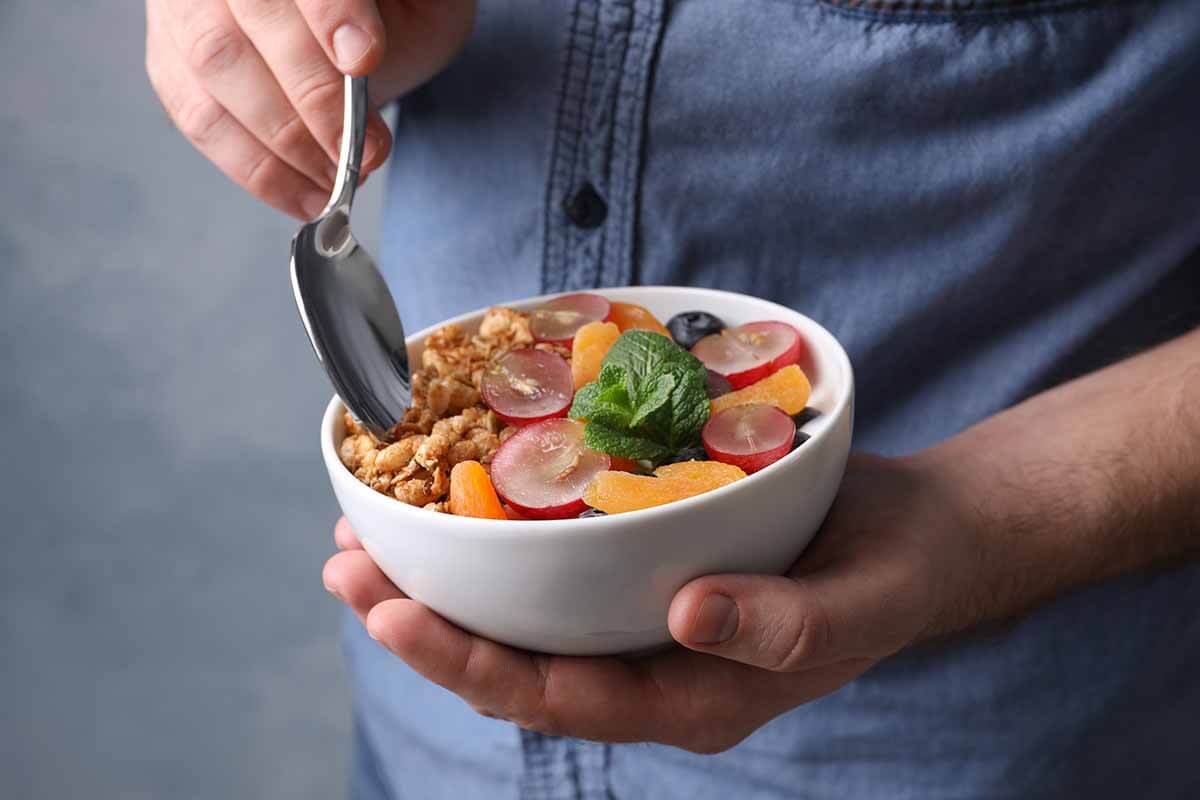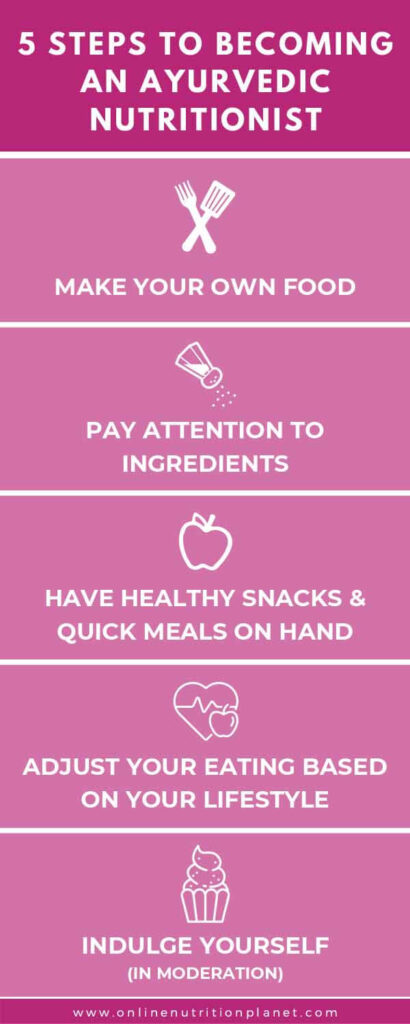Pretty much everyone wants to eat healthier, but this is often easier said than done. Choosing to eat healthier can be hard, especially if you’re new to it and have a busy life. But there are some ways to ease into the transition and make this lifestyle change easier.
Tips to eating healthy as a beginner include making your own food, paying attention to ingredients and nutrition labels, having healthy meals and snacks on hand, fitting your eating habits to your lifestyle (not the other way around), and allowing yourself to indulge in moderation.
Article Contents
What Does It Mean To Eat Healthy?
Eating healthy involves incorporating more unprocessed foods into your diet, such as whole grains, lean proteins, fruits and vegetables, dairy products, and healthy fats. Generally, this means cutting or reducing processed foods, artificial flavors and sugars, foods with high salt and saturated fat content, and refined foods.
A great way to begin the transition is to focus on foods that taste great and are good for you, especially if they’re easy to make and fit into your lifestyle. It’s not about calorie counting, restricting foods, or dieting— after all, you’re not going to stick to eating healthy if it makes you miserable.
Why Is It Important To Eat Healthy?
Eating healthy foods can also improve the health of your heart, gut, skin, teeth, eyes, muscles, digestive system, and bones. It lowers the risk of heart disease, diabetes, and some cancers. Eating healthy can also improve your mood and memory.
Eating healthy isn’t a cure-all, but it will make you feel better overall. It can also help people with specific medical conditions and supports healthy pregnancies and breastfeeding.
Keep in mind, being healthy isn’t synonymous with one body type. People who are skinny aren’t necessarily healthy, and people who eat healthy aren’t always skinny. Eating healthy has less to do with how you look, and more to do with how you want to feel.
How Do I Start Eating Healthy For Beginners?
To start eating healthy as a beginner, identify which healthy foods and ingredients you already like. From there, you can begin planning dishes around these foods and expanding your palate to similar foods. Educating yourself on what constitutes a ‘healthy’ food will also help you find new recipes and foods to try.
5 Tips To Start Eating Healthy As A Beginner
Eating healthy is easy in theory, but can be substantially more difficult in practice. Thankfully, there are plenty of resources to help with this transition. We’ve compiled five tips below that can help jump start your journey to healthier eating.
Make Your Own Food
An easy way to eat healthy is to make your own food. You may not be able to grow your own food, but you can certainly pick out appropriately healthy foods at the grocery store and make your own meals versus buying pre-made meals or going out to eat. This also gives you control over the ingredients themselves, which are a critical component of healthy eating.
Below are some tips on how you can make grocery shopping for healthy foods easier:
- Stick to the edges of the grocery store. Fruits, vegetables, lean proteins, dairy, and other unprocessed foods are typically around the outer rim of grocery stores, while processed foods and snacks take up the bulk of the middle aisles.
- Focus on healthy foods you know you like and try one or two new foods each week. If you love apples and carrots, then stock up on those. Throw some chickpeas or squash in there, but don’t push yourself too far outside your comfort zone.
- Try healthy versions of your favorite dishes. Try using whole grain noodles or shredded squash in lieu of traditional pasta, chocolate chip zucchini bread instead of chocolate chip muffins, homemade fruit sherbet and popsicles instead of ice cream, etc.
When it comes to eating healthy, slow and steady is a good motto. There’s nothing wrong with focusing on foods you already like and then slowly expanding your palette.
Thankfully, there’s a veritable library of healthy recipes online and on social media (Pinterest is particularly rife with recipes). Find the recipes that work best for you in terms of taste and prep and cook time.
Pay Attention To Ingredients
Don’t be intimidated by nutrition labels or ingredients list. While these can be overwhelming at first, there are some general rules of thumb to help you dechipher them and pick out healthier foods:
- Stay away from foods with more than 10 ingredients; the more ingredients a food has, the more processed it probably is
- Pre-packaged, canned, and frozen foods generally aren’t good for you, though this isn’t always the case; make sure to check the protein, fat, and sodium levels
- Avoid ingredients that have ‘hydrolyzed’ or ‘modified’ on them or end in ‘-ose’ (code for added sugar)
- Unsaturated fats and omega-3 fatty acids are okay, but try to steer clear of saturated and trans fats
- Whole grain foods are generally healthy and can provide a solid recipe base; these include whole grain bread and paste, brown rice, quinoa, and oats
While you’re already looking at the nutrition label, take a peek at the portion sizes. Even healthy foods like nuts or fruits can be bad for you if you’re eating too much of them. For foods like pastas or rice, note whether the serving size is for before or after it’s cooked.
And since you’re focusing on healthy eating, make sure to watch what you’re drinking, too. Water is (obviously) the healthiest beverage, but by no means the only kind you can have. Lemonades, teas, and naturally flavored water are also great alternatives.
Coffee, soda, and hot chocolate usually aren’t healthy and involve you drinking calories rather than eating them. Try limiting these, getting smaller sizes, or switching them out for healthier alternatives.
Have Healthy Snacks And Quick Meals On Hand
There are inevitably going to be days when you just can’t spend 30 minutes or more on a meal, whether it’s because you’re starving right then or are pressed for time. When this happens, you’re going to be tempted to grab something that’s quick and easy— and probably unhealthy.
No judgement here, we’ve all done it. But to avoid unplanned snacking, you’ll need to be prepared. This involves:
- Buying healthy snacks that you can grab and go. Whole grain chips and crackers, fruits or vegetables, nut mixes, and meat and cheese protein packs are all examples. If possible, find snacks that are already pre-portioned into individual bags.
- Finding recipes that you can cook in 10 minutes or less. Typically, this involves meals that have minimal prep. Always keep a supply of the ingredients needed for these recipes so that you’re prepared.
- Prepping snacks and meals ahead of time. Meal prepping is one of the easiest ways to make sure there’s always healthy food on hand, even if you’re short on time. You can also do this with snacks, just in case you want lighter fare.
The key to this step is giving yourself time. It’s going to take a while to curb your impulses and redirect them from snacks to healthier foods. It may also take you a few weeks to find recipes that are tasty, healthy, and quick.
In fact, time is an important aspect of healthy eating for beginners in general. You’re not going to do a complete 180 and switch from your current diet to healthy eating. If you try to change overnight, the harsh reality is that you’ll fail.
Instead, try gradually changing your eating habits. Cut back from two sodas each day to one, half your coffee creamer or sugar content, pick out one snack instead of two, etc.
Adjust Your Eating Based On Your Lifestyle
Healthy eating should fit naturally into your lifestyle. Rather than designing your life around healthy eating, it should simply slot into your natural eating and snacking habtis.
Eating more healthy is already going to be a change— perhaps a big one, depending on your current dietary habits. So the less you have to change other aspects of your life, the more successful you’re likely to be.
If you’re struggling with how to incorporate healthy eating into your lifestyle, here are a few ideas:
- For Picky Eaters – Identify which healthy ingredients or foods you do like and plan your meals around them. Find recipes that heavily rely on these foods. When you’re ready, look for ingredients that are similar.
- For ‘On The Go’ Eaters – For those of us who are always going, going, going, it’s important to find recipes that are easy to make or easy to meal prep. Having a steady cache of these will be the key to maintaining a healthier diet.
- For Indulgent Eaters – Eating is a pretty common occurrence, so it’s good if you actually enjoy it. But eating better doesn’t mean depriving yourself. Focus on meals that are both decadent and healthy.
The rising availability of meal prep and food delivery services makes eating healthy easier than ever before. There are entire companies built around helping you eat better and catering to your preferences.
Alternatively, you can look into apps that will allow you to track your meals and calories, save your favorite recipes, and coach you through the transition to eating healthier.
Indulge Yourself (In Moderation)
Eating healthy doesn’t mean that you never have anything unhealthy ever again. Instead, it means that the majority of your diet is food that your body can use for fuel.
If you really like chips or sweets, you can still have them— just remember to eat them in moderation. Eating healthy should be a gradual lifestyle change that suits you and makes you feel better, not miserable.
Here are some tips on how to indulge yourself without ruining your meals:
- Check the portion size and stick to it. Separate your portion into a separate container and then put the treat away.
- Don’t beat yourself up if you slip and eat a bit more junk food than you planned on. Instead, decide to do better tomorrow and give yourself a break today.
- Plan your snacks ahead of time instead of indulging on a whim or based on emotions. Indulge after dinner, for example, or during events like a movie night.
- Recognize when you’re using food to deal with specific emotions. Many people turn to junk food when they’re bored or upset, which leads to bad habits that are hard to break.
You can also try modifying your favorite treats, exactly like you can do with your main meals. Look up recipes for heathier cakes, cookies, chips, etc. For example, you could substitute regular chips for seaweed chips or apple chips.
Alternatively, you can look into changing recipes at the ingredient level and substituting healthier alternatives. For baking, this could mean using whole grain flour, almond flour, or quinoa flour; using dark chocolate or pure cocao or cocoa instead of milk chocolate; or using fruit or other natural sweeteners in lieu of sugar.
The goal isn’t to associate unhealthy foods with negative emotions, but rather to acknowledge that they have their time and place. Sweets and treats can be part of your diet, but they shouldn’t be make up the majority.
Final Thoughts: Eating Healthy As A Beginner
Eating healthier won’t happen overnight, especially for beginners. But there are a few steps you can take to start the transition, such as making your own food and being prepared for days when you’re pressed for time.
With some determination and flexibility, you’ll be able to find recipes that work for your lifestyle and taste preferences. From there, you can gradually substitute foods for healthier alternatives. Before you know it, you’ll have a kitchen full of healthy meals and snacks.





